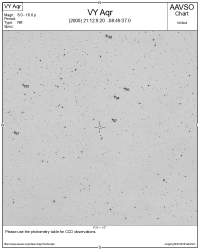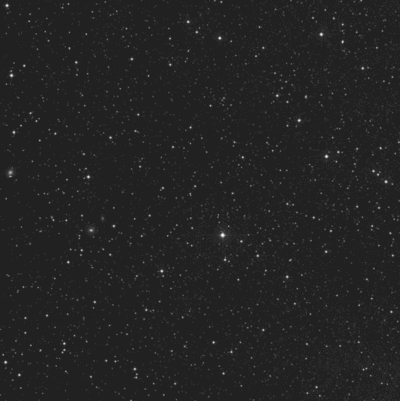[/caption]According to AAVSO Special Notice #114 prepared by Matthew Templeton and released just a few minutes ago, dwarf nova VY Aquari is now rebrightening and observers are asked to contribute their data. VY Aquari has been fairly quiet since its last superoutburst of 10.2 magnitude on June 30, 2008 and is on the rise again…
“Several observers have reported that the dwarf nova VY Aqr (RA 21 12 09.20 Dec 08 49 36.5) has rebrightened since fading from its initial superoutburst. Although VY Aqr has been classified as a WZ Sge-type dwarf nova, previous superoutburst rebrightenings have not been well-observed. Continued monitoring of VY Aqr for the next several weeks is strongly encouraged. Both visual and CCD time-series observations are needed, the former to track the overall light curve, and the latter to study superhumps and short-term variability. Both positive and fainter-than estimates are valuable, so please continue to monitor VY Aqr if and when it becomes faint again — it may undergo further rebrightenings during this outburst.”

Dwarf novae are distinct from classical novae in other ways; their luminosity is lower, and they are typically recurrent on a scale from days to decades. The luminosity of the outburst increases with the recurrence interval as well as the orbital period; recent research with the Hubble space telescope suggests that the latter relationship could make dwarf novae useful standard candles for measuring cosmic distances.
Thanks to recent studies by R. E. Mennickent (et al): “The tomograms reveal complex emission structures that can be identified with the accretion disc, the bright spot and, in the case of VY Aqr, the secondary star. For the first time, the white dwarf is detected unambiguously in the spectrum of VY Aqr.”
Why not check it out yourself? If you have a GoTo telescope, set it on the coordinates listed above and compare what you see with the wide angle chart (courtesy of AAVSO), then up the magnification and compare the field with the Palomar Sky Survey plate image during minima. We’d love to hear about your experience!


July 30th, 2008?
oops. that was june 30, 2008…
thanks, daniel. vacations are dangerous things… 😉
Hmm, that was a conventional holiday yes ?
Not a slip from some skip into the future holiday we are all reading about these days ??
(heheheeee… actually it was a rather normal holiday, i just participated in a lot of things i wouldn’t normally do. ;))